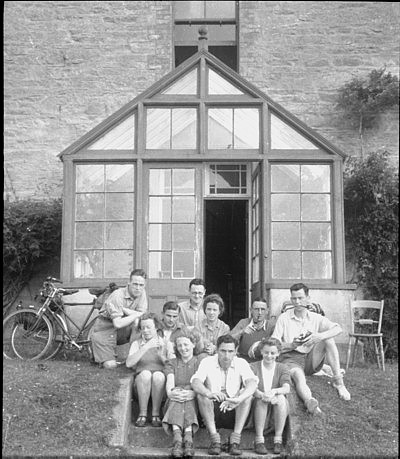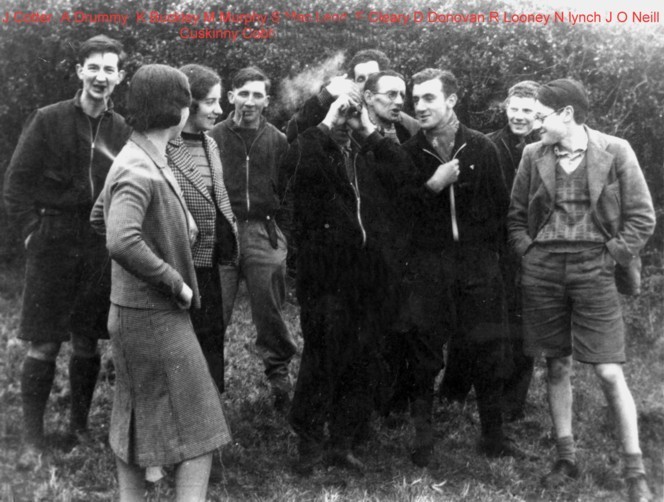Friends Depart
With the outbreak of war on the 3rd September 1939 people lived in dread
of an imminent invasion by the Allied Forces or the Axis Powers. Food,
Fuel and Firepower were short. Camping and drilling were the order of
the day.
Cycling
was still very strong both in competition and touring and great and
lasting friendships had sprung up amongst the lads and lassies.
Many farewell
parties were held in Cork as the CTC members, returning home to join
up, took ship for England.
A true stalwart then
and now was George Harding (later a Regional President)
George was a member of the committee of the Grocers Club and the CTC.
It was from these
bodies that that initially the early members came. As most of them were
long distance cyclists, the idea of an organization like An Óige
having simple hostel accommodation to assist them on their travels was
a great incentive.
These were often placed in strategic locations linking up one CTC house
with another or located in an area away from any form of hostel or accommodation.
Many joint cycling
trips around the country were undertaken by both groups and use was made
of the CTC houses and the few scattered hostels in Munster
On the 5 th of October 1939 a meeting of Cork members was held. A committee
of 7 was formed . It was to be called the Cork Group committee
Gortavalig 1940
Pride of place as the very first hostel in Cork went to Gortavalig. It
very nearly was in Cobh as plans were very far advanced in acquiring Glanmore,
the home of the Swanton family. There was a lovely avenue sweeping up
to the house. There was a garage, a harness room and a passage , one large
bedroom and three small rooms. There were three lofts and it was proposed
to have a separate yard for the wing on top.
Mr .Swanton who had retired from the navy and his wife were appointed
wardens. The meeting in April was attended by Terry Trench, Theckla Beere,
P. Thompson and Jack Sutton. Quotations had been received from Jim Casey,
Plumber, Cobh for installing two wc's. Then all of a sudden the whole
scheme fell through.
The hunt started
again and before the end of the year work was well underway in providing
a hostel at Gortnavalig House near Bantry Co.Cork.
Happily Anne Swanton continued on in An Óige.
This was a lovely
hostel with a lovely location and was situated five miles from Glengarriff
and six miles from Bantry. It was 200 yards south of of the main Bantry-
Glengariffe road marked on the 1'' O.S. map. 120 feet above sea level
1/4 mile from the shore of Bantry bay.
It was officially opened at Easter 1940. It
had been a close shave as far as a hostel in Cobh was concerned and the
hostel equipment had to be brought back from Glenmore House by train and
then on by lorry to Glengarriff.
We got a grant of £10 around early December 1939 and straight away spent £11- 8- 10
Shopping
list for Gortavalig YH
A trip was made by
rail to Bantry and we established by walking that it was 6 miles to the
hostel.
There was also a Glengarriff- Bantry-Cork bus however this was very infrequent.
The Post Office was at Ballylickey Bridge 3 miles away . However there
was a letter box at the entrance.
There were special forms to be filled out by "aliens". These were issued by the Dept. of Defense and had to be kept under lock and key and dispatched promptly by post to Army H.Q. in Dublin. All maps especially Ordnance Survey had to handed up to the authorities in case they fell into enemy hands.
We knew that the
Catholic Church was 2 1/2 miles away at Coomhola and that the Church of
Ireland was 2 miles away at Snave. There were also stores at Coomhola
and Ballylickey.
However the notice board remained blank for the "duration"as
this information could not be advertised.
Water for Drinking came from the well which was 100 yards away. Rainwater
was used for washing and the hostellers cooked on an old range.
The rates for a half year were £2-17 -4 and the rent was £15
a year.
Railway and I.T.A posters were used in decorating the Common Room thus
we became acquainted with works of Paul Henry

ref Jack Colemans
Notebook
The warden was installed at Gortavalig on the 11th February 1940 after
a work party of 5 women and 11 men and 2 drivers had got the hostel ready
for occupation.
Enthusiasm seems to have waned as the next entry is a telegram (1s- 5d)
sent to Jack Sutton advising the temporary closure of the hostel due
to a water shortage 19/8/40
The
American Note
After DeValera said " no " to the now historic American Note
whose tone and content and purpose was to land forces, seize the country,
and occupy the ports, the combined forces of the state were put on alert.
Early in 1941 the Army, Air Force, Navy and L.D.F. (local de fence force)
were called up to defend the south coast of Ireland from a possible invasion
by the might and power of America. I amongst others patrolled for miles
the coast at Kinsale for three to five days until the order came to stand
down.
I was armed to the teeth with 5 rounds of ammunition and a Lee Enfield
rifle. Well the south coast of England was was being defended by my first
cousin -armed with a four pronged pitchfork-a bigger joke.
During
the war
The membership remained about 40-50. The committee during the war years
was Misses Kay Buckley, A Drummy, Mary Tobin. Messers J. Cotter, JC Coleman,
M Murphy , S McLeod, F Cleary, R Looney, T Crone, M Lynch, J O Neill.
Meetings took place at members houses.
A meeting held in St. Francis hall and a committee elected consisting
of :- Chairman JE Cotter, Vice Chairman Kay Buckley, Sec. V Godsil, Treas.
Frank Murphy.

In 1943 new members joined like Kay Buckley, Annie Drummy, Mary Tobin , Noel Lynch and Ray Looney
Under the wonderful
leadership of a sincere quiet but forward thinking Chairman the late James
E Cotter things really got moving in Cork and Kerry
Kay Buckley was his Vice Chairperson and with Frank Murphy as Treasurer.
I (Vincent) was secretary . As usual in those days as money was short,
many of our letters we delivered ourselves .
Our first Life Member
was Eoin (Pope) O Mahony with Anne Swanton of Cobh a close second.